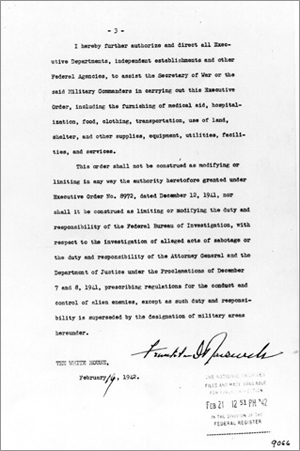This Month in History: Executive Order 9066 – February 19, 1942
On February 19, 1942, President Franklin D. Roosevelt issued Executive Order 9066, authorizing the establishment of “military areas… from which any or all persons may be excluded,” giving the Secretary of War the power to oversee the removal of such persons.1 This order decisively targeted the Japanese residents living on the West Coast from first generation immigrants to second and third generation Japanese Americans.
The order also stated:
“The Secretary of War is hereby authorized to provide for residents of any such area who are excluded therefrom, such transportation, food, shelter, and other accommodations as may be necessary… to accomplish the purpose of this order”.2
This action led to the construction of internment camps, displacing and disrupting the lives of over 100,000 Japanese Americans. While this order seems to be justified by military necessity and the threat of a Japanese invasion on the West coast, it must also be viewed in the context and history of anti-immigration and discrimination of Asian Pacific Americans in the U.S. dating back to the Exclusion Acts of the 1880s.
Executive Order 9066 faced several legal challenges of its constitutionality during its implementation and after the war. Most famously, it was challenged in the Supreme Court in Korematsu v. United States, but also in the Hirabayashi and Endo court cases. The court did uphold the exclusion measures outlined in Executive Order 9066 but ruled against imprisonment of any citizen not proved to be disloyal in Ex parte Endo.3
On August 10, 1988, President Ronald Reagan signed the passage of the bill H.R. 442 by the 100th Congress. Now known as the Civil Liberties Act of 1988, the bill officially redressed and apologized for the injustices endured by Japanese Americans during World War II.
Although the civil rights climate has changed since 1942, this episode in American history holds great significance. Today, in post-9/11 politics, Executive Order 9066 serves as a warning and reminder to protect and preserve the freedoms of all U.S. citizens, regardless of race or creed.
1 Exec. Order No. 9066, 3 C.F.R. 1092-1093 (1942). Print.
2 Exec. Order No. 9066, 3 C.F.R. 1092-1093 (1942). Print.
3 Robinson, Edward T. “The Japanese Internment Cases Revisited.” OAH Magazine of History 7.2 (2003). JSTOR. Web. 23 Jan. 2011. <http://www.jstor.org/stable/25163583>.



Discussion